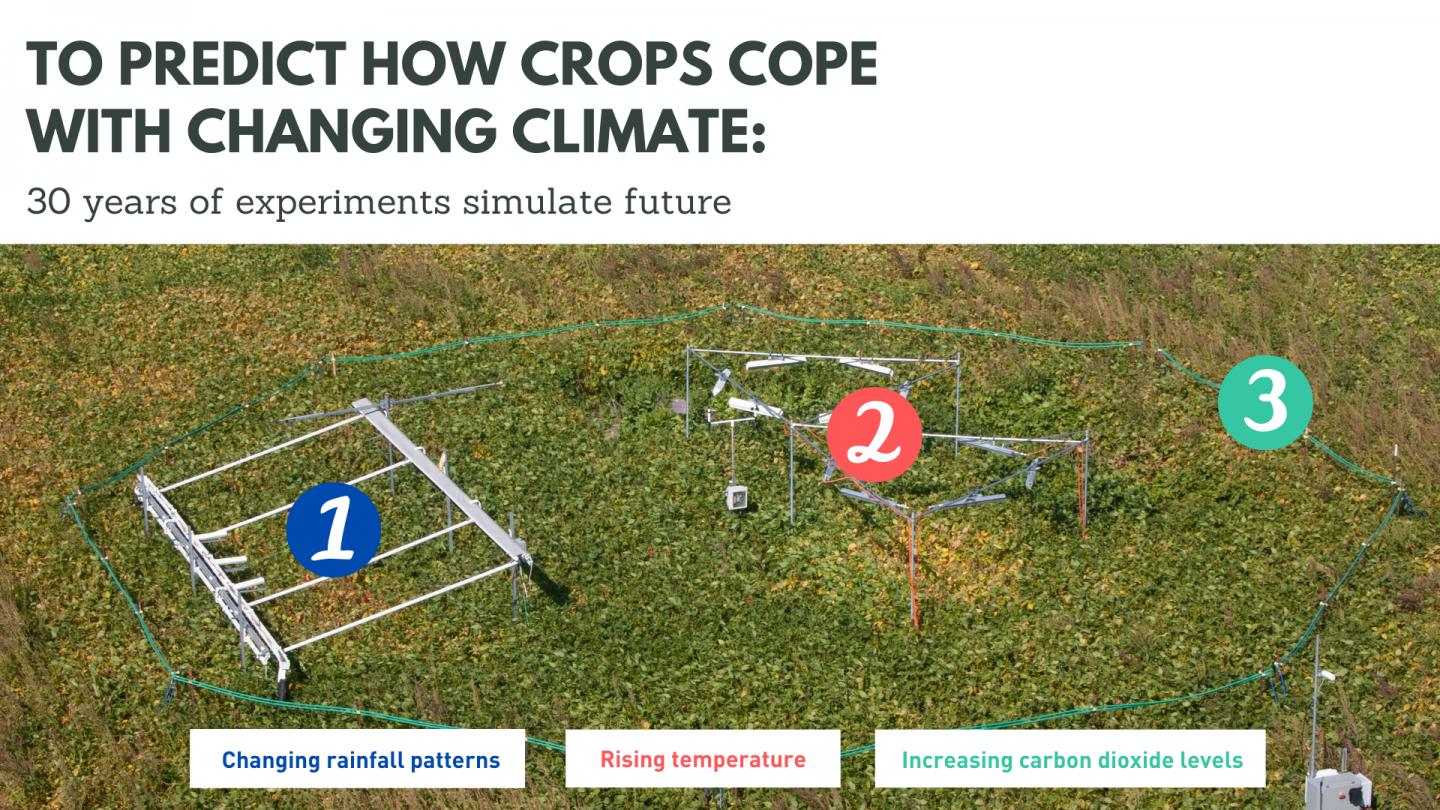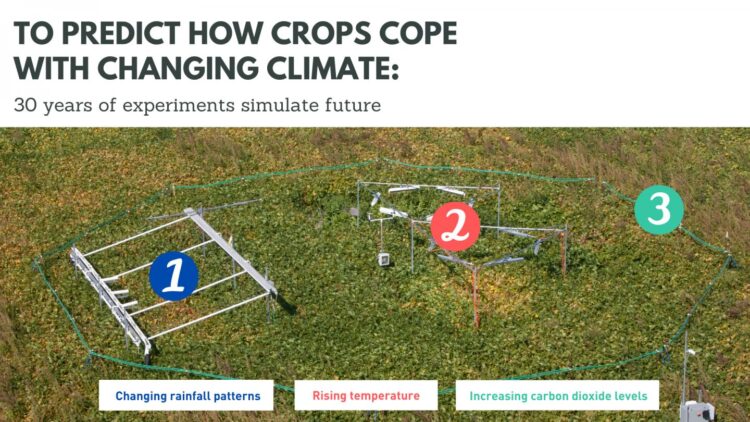
Credit: University of Illinois
Five years ago, the United Nations committed to achieving the Sustainable Development Goal of Zero Hunger by 2030. Since then, however, world hunger has continued to rise. Nearly 9 percent of our global population is now undernourished, according to a 2020 report from the FAO, and climate variability is a leading factor driving us off course.
Over the past 30 years, a network of 14 long-term research facilities spanning five continents has simulated future levels of carbon dioxide (CO2) to forecast the impact on crops. Importantly, these ‘Free-Air Concentration Enrichment’ (FACE) experiments are conducted outside in real-world field conditions to capture the complex environmental factors that impact crop growth and yield.
Today, a review published in Global Change Biology synthesizes 30 years of FACE data to grasp how global crop production may be impacted by rising CO2 levels and other factors. The study portends a less optimistic future than the authors’ previous review published 15 years ago in New Phytologist. “There are likely genetic solutions, should society decide to act on these–however, time is short,” said co-author Stephen Long, Ikenberry Endowed University Chair of Crop Sciences and Plant Biology at the University of Illinois.
“It’s quite shocking to go back and look at just how much CO2 concentrations have increased over the lifetime of these experiments,” said co-author Lisa Ainsworth, a research plant physiologist with the U.S. Department of Agriculture, Agricultural Research Service (USDA-ARS). “We are reaching the concentrations of some of the first CO2 treatments 30 years back. The idea that we can check the results of some of the first FACE experiments in the current atmosphere is disconcerting.”
The reviews consider two groups of plants: most crops are C3 (including soybean, cassava, and rice), which are less efficient at turning CO2 and light into energy through the process of photosynthesis. C4 plants, such as corn and sugarcane, supercharge photosynthesis by using some of the light energy they receive to concentrate CO2 within their leaves, making them up to 60 percent more efficient.
In C3 crops, oxygen inhibits photosynthesis, which is diminished by increasing the concentration of CO2. This is why many commercial greenhouse growers raise CO2 levels to boost photosynthesis and the yields of tomatoes, peppers, cucumbers, and other greenhouse crops. So will the increase in atmospheric CO2–that we are causing through our use of fossil fuels and deforestation–have the same effect?
Results
As in their previous review, but this time with ten times more studies, the authors show that elevation of CO2 to levels expected for the second half of this century could increase C3 crops’ yields by 18% with adequate nutrients and water.
“So should we anticipate a bounty as CO2 rises?” said Long, who is a member of the Carl R. Woese Institute for Genomic Biology. “Sadly not because rising CO2 is the primary cause of change in the global climate system. The anticipated 2° C rise in temperature, caused primarily by this increase in CO2, could halve yields of some of our major crops, wiping out any gain from CO2.”
While CO2 increased yields, it also caused important quality losses; many crops showed lower mineral nutrient and protein contents. This yield response is also much smaller under the conditions of low nitrogen fertilization, which is the situation for many farmers in the world’s poorer countries. Alarmingly, what has become apparent since the first review is that our major food crops become considerably more vulnerable to pests and diseases at higher CO2.
“Lots of people have presumed that rising CO2 is largely a good thing for crops: assuming more CO2 will make the world’s forests greener and increase crop yields,” Ainsworth said. “The more recent studies challenge that assumption a bit. We’re finding that when you have other stresses, you don’t always get a benefit of elevated CO2.”
On a more positive note, the authors show that there is sufficient genetic variation within our major crops to overcome some of these negative effects and capitalize on the yield benefit of higher CO2. “Where genetic variation is lacking, there are some bioengineering solutions with one already demonstrated to prevent yield loss when the temperature is raised with CO2,” Long said. “But, given the time taken to develop new crop cultivars, this potential could only be realized if we start now.”
Future Research
“We are driven by a motivation to prepare for the future and to identify the traits that are going to be important for maximizing this CO2 response while dealing with the aspects of global change that may drive down yields,” Ainsworth said. “The last 15 years have taught us to account more for the complex interactions from other factors like drought, temperature, nutrients, and pests.”
Researchers should explore a wider variety of crops and genotypes as well as different management practices, such as seeding density, tillage, and cover crops, to find other solutions that are less burdensome on the environment, Ainsworth said.
Also, the FACE community needs greater accessibility to all of the experimental results.
“We don’t have a formal database of all of the FACE results from the last two decades of research,” Ainsworth said. “There’s an opportunity to put all of the information together in one place and make it openly accessible for everyone to use and to encourage more people to use the data to think about solutions.”
“The ideal solution will be that we dramatically decrease our release of CO2 into the atmosphere and quickly achieve carbon neutrality,” Long said. “But we also need to take out an insurance policy against this not being achieved. That is, we need to breed and engineer future-proof crops and systems that can be sustainable and nutritious under the combined changes in atmospheric composition and climate to help realize the goal of zero hunger.”
###
Established in 2007, the Carl R. Woese Institute for Genomic Biology is an interdisciplinary institute dedicated to transformative research and technology in life sciences using team-based strategies to tackle grand societal challenges. The IGB serves as a centralized location for biological and biotechnological research at the University of Illinois.
Media Contact
Claire Benjamin
[email protected]
Original Source
https:/
Related Journal Article
http://dx.





